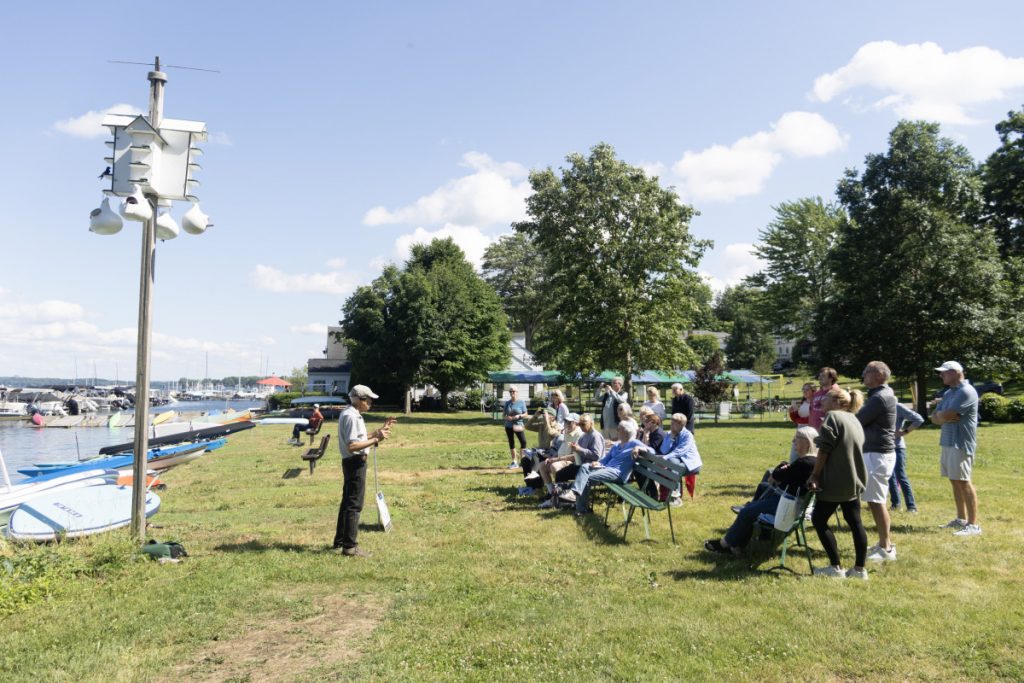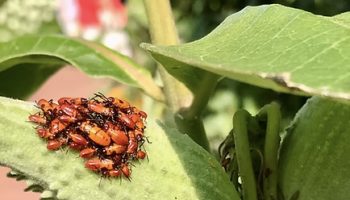
Jack Gulvin leads Week One’s Purple Martin Talk last Thursday near Sports Club; by his math, it was Gulvin’s 97th purple martin program with the Bird, Tree & Garden Club.
Last Thursday, a crowd of 20 Chautauquans gathered in the grassy clearing next to Sports Club’s shuffleboard courts. A picnic table and two benches had been uprooted from their usual homes to form a makeshift seating area, all facing a thick wooden pole, on top of which sits a pristine white bird house. If his calculations were accurate, Jack Gulvin was leading his 97th Purple Martin Talk.

A purple martin comes in for a landing at one of the elevated bird houses near Sports Club.
Every summer since 1999, Gulvin has given a Bird Tree & Garden Club Purple Martin Talk at 4:15 p.m. on the first four Thursdays of the Chautauqua season — the period during which most of the baby purple martins hatch and begin to fly. The format for each talk has been the same since the very first one 25 years ago.
“My first summer, they screwed up on the announcement of the time, and I was going to start right out, first thing, by lowering the martins and showing (the audience) the birds in the nest,” he said. “But they advertised 4 p.m. and 4:15 p.m., so I thought, ‘All the people showing up at 4:15 p.m. are going to miss out.’ So I lowered the house again at the end. That worked great, and that’s what I’ve done ever since. That screw up was actually very beneficial.”
Since that very first Purple Martin Talk, Gulvin has lowered the purple martin house at 4:15 p.m. on the dot; a volunteer shows the audience a nest tray filled with babies while he provides some background on the birds. Then, he sends the house back up the pole, and answers any questions from the audience “until the Bell Tower rings.” Once the bell rings, he lowers the house one more time, shows the babies again, and then sends the house back up until the next week.
But Gulvin’s Purple Martin Talks aren’t the only time he’s lowering the bird house and taking a look at all the baby martins.
Purple martins call Chautauqua home from early April through early September, when they return home to the Amazon Basin. In late May, the martins will begin building their nests; once they begin gathering nesting material, Gulvin will begin his nest checks, which he will conduct every five days until every last baby has fledged — the technical term for when juvenile birds begin flying. During these nest checks, Gulvin will visit all five purple martin bird houses on the Institution grounds, lowering each house and checking each nesting compartment for parasites, and replacing the nesting material in each as needed.

Gulvin checks a nesting compartment last Thursday.
When he was first hired as the naturalist at Chautauqua, though, Gulvin said completing his nest checks proved difficult because of the state of the bird houses.
“They’d been neglected for two or three years,” he said. “There were starling nests in there and sparrow nests in there — all kinds of junk.”
Even though he’s fixed up all of the martin houses, which cost an average of $1,500 each and are specifically designed to let purple martins in and keep other bird species out, Gulvin has still had a few run-ins with sparrows and starlings — both birds that can prove disastrous for a purple martin colony.
On his very first day, he remembers Louise Chambers, then the assistant director of the Purple Martin Conservation Association, introducing him to all of the bird houses and the martins living in them. The association, based in Erie, Pennsylvania, had been managing the martin houses and delivering Purple Martin Talks prior to Gulvin’s hiring, and Chambers was familiar with the purple martins at the Institution. She found a family of sparrows had taken over one of the nest compartments in the martin house by the shuffleboard courts.
“She just walked on over to the edge of the lake, came back with the biggest smile on her face and an empty nest tray, and she said, ‘They all sank,’’’ Gulvin recalled. “This lady meant business.”
Even earlier this summer, Gulvin found a sparrow nest in one of the purple martin nest compartments. He set a trap for the adults, hoping to catch the male; if he caught the female, he explained, the male would just find a new mate and take over a different nest. But since he caught the male, he was able to remove it from the area and clear out the nest, hopefully preventing the sparrows from returning.
Sparrows, along with European starlings, are invasive species that pose a massive threat to purple martin colonies; they will force the purple martins out of their nests, often violently, and once the martins are forced out, they will not come back.
So far this summer, sparrows and starlings haven’t been causing any major problems for the purple martins of Chautauqua. This is welcome news to Gulvin, who said the number of martins successfully hatching and then fledging has been steadily declining since reaching a peak of 423 in 2004. In 2023, just 139 purple martins fledged — the same number as Gulvin’s very first year at the Institution in 1999, and the lowest number throughout his tenure as naturalist.
“I have to be concerned about that,” he said. “If they (keep) on going that way, pretty soon I won’t have any martins there to show to people for the Purple Martin Talks.”
But all hope is not lost for Chautauqua’s purple martins.
In addition to taking care of the purple martins at the Institution, Gulvin also cares for a friend’s martin colony on the shore of Lake Erie; they have two poles, each pole with 12 nesting compartments. Every single one is full; every single nest has five or six eggs; every single egg hatches; and every baby martin goes on to fledge.
At Chautauqua, he has spent the past few years trying to figure out why the purple martin population has been ticking downward. His working theory is a lack of insects available for the martins to eat, due in large part to a lack of native plants on the grounds. Since purple martins have become completely dependent on humans to find housing and to survive during their breeding season, it’s up to humans to ensure they continue surviving.
One group dedicated to ensuring the survival of the purple martins is the aforementioned Purple Martin Conservation Association, who keep a database of every purple martin that is banded by humans (when a rubber leg band with a unique number is attached to the bird). They also publish guides on best practices for attracting a purple martin colony, maintaining that colony, and ensuring the colony’s long-term survival.
Many Chautauquans may know Gulvin for collecting their recyclable cans and bottles throughout the season. At the end of each season, he redeems those bottles and cans in exchange for cash. Last season, he collected over 200,000 cans, which turned into over $11,000 — $10,000 went to the Purple Martin Conservation Association.
“I don’t need it,” he said.
When Gulvin came to Chautauqua 25 years ago, he could hardly be considered an expert on purple martins, explaining that most birders don’t think twice about them. But when he found out that he had two weeks to essentially become an expert on the Chautauqua natives, he dove in head first. Since his first Purple Martin Talk in 1999, Gulvin has spoken about purple martins to over 2,000 people, each time taking great pride in the fact that he gets to teach people something new.
“I love it when I can find something new and different,” he said. “I can point out a lot of things that people otherwise would probably not notice.”
At 4:15 p.m. today, a crowd of Chautauquans will gather in the grassy clearing next to Sports Club’s shuffleboard courts. A picnic table and some benches will be uprooted from their usual homes to form a makeshift seating area, facing a thick wooden pole, on top of which sits a pristine white bird house.
If his calculations are accurate, Jack Gulvin will be leading his 98th Purple Martin Talk.




